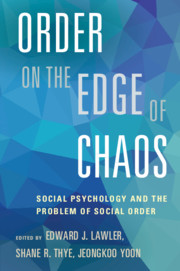Book contents
- Frontmatter
- Contents
- List of Contributors
- Preface
- 1 Social Psychology of Social Order: An Introduction
- 2 The Evolutionary Biology and Sociology of Social Order
- 3 Social Rationality and Weak Solidarity: A Coevolutionary Approach to Social Order
- 4 An Integrative Theory of Action: The Model of Frame Selection
- 5 The Center Cannot Hold: Networks, Echo Chambers, and Polarization
- 6 Social Exchange and Social Order: An Affect Theory Approach
- 7 Institutions, Trust, and Social Order
- 8 Identity Verifi cation and the Social Order
- 9 Identities, Roles, and Social Institutions: An Affect Control Account of Social Order
- 10 The Gender Frame and Social Order
- 11 Status, Power, and Social Order
- 12 Interaction Order: The Making of Social Facts
- 13 The Arts of Together: Social Coordination as Dyadic Achievement
- 14 Dignity as Moral Motivation: The Problem of Social Order Writ Small
- 15 The Legitimacy of Groups and the Mobilization of Resources
- Commentary: Contrasts and Complementarities
- Index
- References
8 - Identity Verifi cation and the Social Order
Published online by Cambridge University Press: 05 December 2015
- Frontmatter
- Contents
- List of Contributors
- Preface
- 1 Social Psychology of Social Order: An Introduction
- 2 The Evolutionary Biology and Sociology of Social Order
- 3 Social Rationality and Weak Solidarity: A Coevolutionary Approach to Social Order
- 4 An Integrative Theory of Action: The Model of Frame Selection
- 5 The Center Cannot Hold: Networks, Echo Chambers, and Polarization
- 6 Social Exchange and Social Order: An Affect Theory Approach
- 7 Institutions, Trust, and Social Order
- 8 Identity Verifi cation and the Social Order
- 9 Identities, Roles, and Social Institutions: An Affect Control Account of Social Order
- 10 The Gender Frame and Social Order
- 11 Status, Power, and Social Order
- 12 Interaction Order: The Making of Social Facts
- 13 The Arts of Together: Social Coordination as Dyadic Achievement
- 14 Dignity as Moral Motivation: The Problem of Social Order Writ Small
- 15 The Legitimacy of Groups and the Mobilization of Resources
- Commentary: Contrasts and Complementarities
- Index
- References
Summary
Abstract
We outline how identity verification has consequences for the construction and reconstruction of the social order. Identity verification occurs when individuals perceive self-relevant meanings in the situation that match who they are in that situation (their identity). Verification of an identity feels good. This generates solidarity (when facilitated by others) and adherence to norms. Identities are verified by individuals controlling the flow of resources in interaction, and it is this flow that maintains the social structure. Resources either can be ready to be consumed (active resources) such as food for nourishment, or they can have some future use (potential resources) such as education for adaptation. We discuss how identity verification is accomplished by using symbols and signs attached to potential and actual resources in situations. The control of resources helps verify not only one's own identity but also others’ identities. Since the process of identity verification produces positive feelings and stronger social bonds, this should facilitate maintenance of the social order. Identity nonverification will have the reverse effect on the social order, generating negative emotions, conflict, and chaos.
In identity theory, identity verification means changing the world (as we perceive it) to be the way it is supposed to be (according to our identity standards). Our perceptions are the meanings that we control to accomplish this. Perceptually, meanings are conveyed through signs and symbols emanating from the situation. Much of the research and theory within the identity theory framework has focused on symbols, whose arbitrary meanings, learned from the common culture, are shared with others. In this chapter, we emphasize this but also bring more attention to the other source of meaning noted by Mead (1934): signs, whose meaning is not arbitrary but is learned by direct experience in the situation. In this way, we begin to delineate more clearly the connection of identities to the material world and the social structure that surrounds and sustains us. We also point to the role of resource flows including actual and potential resources in verifying people's identities and in maintaining the social structure.
- Type
- Chapter
- Information
- Order on the Edge of ChaosSocial Psychology and the Problem of Social Order, pp. 145 - 164Publisher: Cambridge University PressPrint publication year: 2015
References
- 14
- Cited by



